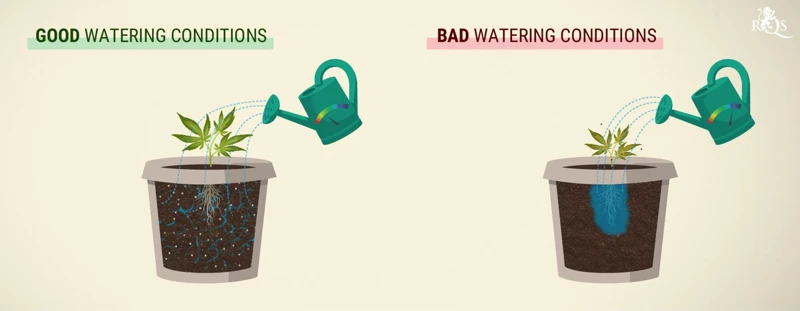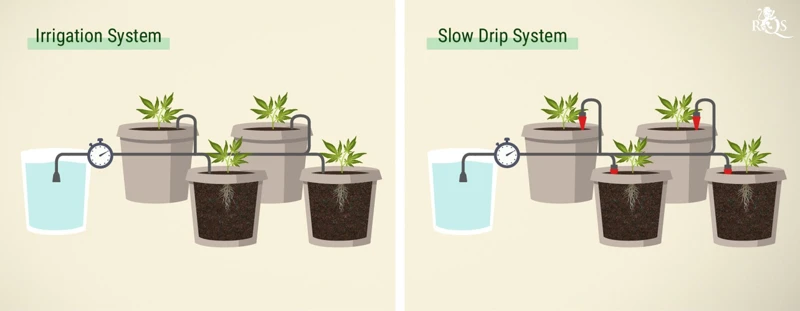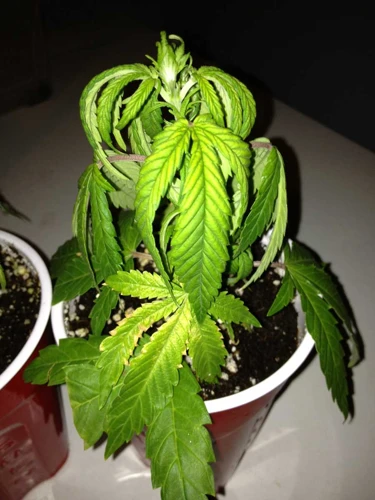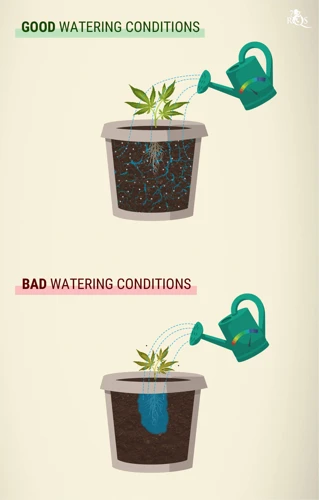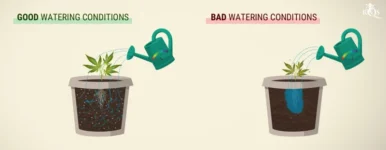
How to Water Cannabis Plants to Avoid Under-Watering
Growing cannabis can be a rewarding but challenging experience, especially when it comes to watering. With so much conflicting information available, it can be perplexing to figure out the best watering practices for your plants. Proper watering is critical to the health and growth of cannabis plants, but under-watering can be just as harmful as over-watering. In this article, we will explore the importance of proper watering, different techniques, frequency, and signs of under-watering. We will also provide step-by-step instructions for effectively watering cannabis plants during different stages of growth, as well as tips and tricks to avoid over-watering. By the end of this article, you’ll have a better understanding of how to properly water your cannabis plants and help them thrive.
Why Proper Watering Matters
Contents
Water is a fundamental requirement for all living organisms, and cannabis plants are no exception. Ensuring that your plants receive adequate water is essential for their growth and development. Under-watered plants can suffer from a range of issues, including stunted growth, yellowing leaves, and poor yield. In this section, we will explore the importance of proper watering techniques for cannabis plants and the harmful effects of under-watering. Additionally, we will provide tips on how to properly water your plants to avoid the negative consequences of under-watering. To learn more about the signs of under-watering, visit our section on signs of under-watering.
The Importance of Water for Cannabis Plants
Water is an essential component for the growth and survival of all plants, including cannabis. Without water, cannabis plants cannot carry out crucial functions such as nutrient uptake, photosynthesis, and transpiration. Water also helps maintain the turgidity, or firmness, of plant cells, which is important for maintaining their structure and preventing wilting.
Cannabis plants require a specific amount of water to grow healthy and strong, and under-watering can have detrimental effects on their growth and yield. Insufficient water can cause stunted growth, yellowing of leaves, and reduced potency of buds. It is important to understand the water requirements of your cannabis plants and provide them with adequate amounts at the appropriate times.
Proper watering can also help prevent the buildup of salts and other minerals in the soil, which can lead to nutrient deficiencies and plant stress. Good watering practices can also enhance the flavor, aroma, and overall quality of the buds. Understanding how to properly water your cannabis plants is therefore crucial for achieving optimal growth, yield, and potency.
The Effects of Under-Watering
Under-watering of cannabis plants can have several negative effects on their overall growth and development. It can lead to stunted growth, poor yields, and even death of the plant. The effects of under-watering are as follows:
| Effects of Under-Watering | Descriptions |
|---|---|
| Poor Nutrient Uptake | Under-watered plants have a reduced ability to absorb nutrients, which can lead to deficiencies in essential elements like nitrogen, phosphorus, and potassium. |
| Reduced Photosynthesis | Water is essential for the process of photosynthesis. Insufficient water supply can cause the plant to slow down or stop photosynthesis, affecting its overall health. |
| Dry and Brittle Leaves | Insufficient water supply can cause leaves to dry out and become brittle. Over time, this can lead to yellowing and browning of leaves, eventually leading to their death. |
| Wilting | Water plays a vital role in keeping the plant turgid, which means firm and upright. Under-watered plants may show signs of wilting, where the leaves and stems become limp and droopy. |
| Production of Fewer Flowers | Under-watered plants tend to produce fewer flowers or buds, leading to poor harvests. This is because the plant focuses its energy on survival, rather than production of flowers. |
| Stunted Growth | Water is essential for cell expansion and elongation in plants. Insufficient water supply can cause growth to slow down or stop. This can lead to stunted growth and reduced yields. |
It is crucial to follow proper watering techniques to ensure healthy growth and development of cannabis plants.
Cannabis Watering Techniques
As a cannabis grower, one of the most important skills to have is knowing how to properly water your plants. But with so many different watering techniques and philosophies out there, it can be overwhelming to know where to start. However, mastering the art of cannabis watering is essential for the health and growth of your plants – and ultimately, the quality of your end product. In this section, we will explore a variety of effective watering techniques and tips for avoiding under-watering. Let’s dive in and learn how to give your cannabis plants the hydration they need to thrive.
Different Methods of Watering
When it comes to watering cannabis plants, there are different methods of delivering water to the plants depending on the preference of the grower. Here are some of the most common methods:
- Watering can: This is a popular method for indoor and outdoor growers. It involves pouring water from a watering can directly onto the soil near the base of the plant. This is a gentle method that allows for easy control of the amount of water being given to the plant.
- Drip irrigation: This is a method that involves a system of tubes with small holes that release water gradually onto the soil. This method is best suited for outdoor grows and can be automated, saving time and effort.
- Flood and drain: This method involves filling a tray or container with water, allowing the plants to absorb the water through the drainage holes at the bottom. Once the water has been absorbed, the tray is emptied. This method is popular for hydroponic grows and is best suited for more experienced growers.
- Aeroponics: This is a high-tech method that involves suspending the plant roots in the air and misting them with a nutrient-rich water solution. This method delivers water and nutrients directly to the roots, which can lead to faster growth and healthier plants. However, it is also the most complex and expensive method of watering cannabis plants.
- Hand watering: This is the most traditional and labor-intensive method of watering. It involves manually watering each plant individually with a watering can or hose. This method allows for close observation of each plant and can be the most effective method for indoor grows or small outdoor gardens.
Each method of watering has its own advantages and disadvantages, but the key is to find the method that works best for your particular growing situation.
Frequency of Watering
Frequency of watering is a crucial aspect of proper cannabis plant care. It is important to find the right balance between watering too frequently and not watering enough. The frequency of watering depends on several factors, such as the size of the plants, the size of the pots, the type of soil or growing medium, the stage of growth, and the level of humidity in the growing environment.
To help determine the frequency of watering that is best for your cannabis plants, follow these guidelines:
- Observe your plants daily: Check your plants daily to see if they are in need of water.
- Feel the weight of the pots: Lift the pots occasionally to feel the weight. If they feel light, it’s time to water.
- Check the soil moisture: Stick your finger about an inch deep into the soil or growing medium to check for moisture. If the soil is dry to the touch, it’s time to water.
- Consider environmental factors: If the temperature is hot and dry, plants will need to be watered more frequently. If the humidity is high, plants may not need to be watered as often.
It’s important not to overwater your cannabis plants as this can lead to root rot and other problems. As a general rule of thumb, water your plants when the top inch of soil or growing medium feels dry to the touch. This will vary depending on the size of the pot and the size of the plant, but it’s better to err on the side of underwatering than overwatering.
In the vegetative stage, cannabis plants typically need to be watered every 2-3 days, while in the flowering stage, they may need to be watered every 1-2 days. However, these are just rough guidelines and you should always check your plants daily to make sure they are not being over or under-watered.
Remember that the frequency of watering will also depend on the growing medium. Soil may hold onto moisture for longer periods than other mediums like coco coir or hydroponics. Make sure to research the ideal watering frequency for the medium you are using to help guide your watering schedule.
In addition to monitoring the frequency of watering, it’s important to ensure that the plants are receiving the proper amount of nutrients and light as well. Proper care will help ensure healthy and productive cannabis plants.
How Much Water to Use
When it comes to determining how much water to use when watering cannabis plants, there are a few factors to consider. It’s important to find the right balance between providing enough water and avoiding over-watering which can be just as harmful to the plants as under-watering.
Factors that Affect Water Usage:
- The size of the plant
- The stage of growth
- The growing medium
How to Determine Water Usage:
- One general approach to determining water usage is applying water until it runs through the bottom of the pot. This helps ensure that the entire root system receives water. However, this technique can be wasteful and may not always be necessary, especially for smaller plants or those growing in small pots.
- Another approach is to touch the surface of the growing medium and feel for moisture. If the soil feels dry at the top (about the first inch), it’s time to water. If the soil feels wet, it’s best to wait a day or two before watering again.
- Water should be applied slowly and evenly around the base of the plant, allowing it to soak into the growing medium.
Special Considerations:
- During the seedling stage, it’s important to use very little water at a time, as the roots are not yet fully formed and can be easily damaged from over-watering.
- Plants in larger pots or those growing in a hydroponic system may require more frequent watering, but smaller pots or those with well-draining soil may require less frequent watering.
By taking into account the plant’s size, growth stage, and growing medium, as well as applying water slowly and evenly, growers can effectively determine how much water to use for their cannabis plants, avoiding both under-watering and over-watering.
Signs of Under-Watering
As a cannabis grower, it’s essential to understand the signs that your plant is not getting enough water. Under-watering can quickly lead to stunted growth, wilting, and even death in severe cases. It’s important to be able to recognize these symptoms, so you can take immediate action to save your plants. In this section, we will cover some visual cues and touch tests that you can use to determine if your cannabis plants are under-watered. Keep in mind that it’s always better to be cautious and water your plants too much than not enough.
Visual Cues
One of the most important aspects of properly watering cannabis plants is being able to identify the signs of under-watering. Visually inspecting the leaves and stems of the plants is one of the most effective methods to determine if they are suffering from insufficient hydration.
Some visual cues to look for include:
- Wilting leaves: One of the most telling signs that a cannabis plant is not receiving enough water is when its leaves start to droop or wilt. This happens because the plant does not have enough water to keep its plant cells turgid, causing it to lose its rigidity and droop downwards.
- Dry soil: Checking the soil moisture level is another way to determine if a plant is under-watered. If the soil is dry or crumbly to the touch, it’s a sign that it needs more water.
- Dull and pale leaves: When plants don’t receive enough water, their leaves start to lose their shine and turn a dull green or yellow color. This happens because the plant is trying to conserve water by lowering its energy production.
- Crispy or brown leaves: If the leaves of the plant are crispy and brown, it means that it may be suffering from extreme dehydration. Brown leaves can also be a sign of nutrient excess, so it’s important to rule out other causes before increasing water intake.
- Curling leaves: Another sign that a plant is under-watered is that its leaves start to curl upwards. This happens because the plant is trying to reduce the amount of water that is being lost through its leaves.
Keep an eye out for these visual cues to ensure that your cannabis plants are receiving the proper amount of water they need to thrive. If you notice any of these symptoms, it’s important to take action immediately to avoid further damage to your plants.
Touch Tests
One of the most effective ways to determine if your cannabis plants are under-watered is through touch tests. These tests involve feeling the topsoil to determine its moisture level. Here are some touch tests you can perform, with some tips to help you accurately interpret the results:
- Finger test: Insert your index finger up to the first knuckle into the soil. If the soil feels dry or barely moist, your plants likely need more water. If the soil feels wet, it is best to wait a day or two before watering to prevent overwatering.
- Weight test: Pick up your plant container and feel its weight. If it feels light, it is likely in need of water. If it feels heavy, the plant has enough water and you can hold off on watering until it feels lighter.
- Soil color test: A healthy, hydrated soil should be a darker hue. If your soil looks light or grayish, it could mean it is too dry.
It’s important to keep in mind that these tests are not always foolproof; environmental factors such as humidity and temperature can also affect the plants’ moisture levels. One tip to ensure your plants are receiving the proper amount of water is to monitor them closely and adjust watering frequency as necessary.
How to Effectively Water Cannabis Plants
Now that you understand the importance of properly watering your cannabis plants and the potential consequences of under-watering, it’s time to learn how to effectively water them. The process may seem simple at first, but there are certain techniques and steps you should follow to ensure your plants receive the optimal amount of water they need to thrive. In this section, we will guide you through the process of preparing water for your plants, determining the best time of day to water, avoiding over-watering, and adjusting your watering practices during different stages of growth. By following these tips and tricks, you’ll be on your way to achieving healthy, vibrant cannabis plants.
Preparing Water for Plants
When it comes to properly watering cannabis plants, it is important to not only consider the amount of water and frequency of watering, but also the quality of the water being used. The following steps can be taken to ensure that the water being used is optimal for cannabis plants:
- Filter the water: It is best to filter the water before use to remove any impurities that can harm the plant. This can be done using a carbon filter or any other appropriate household filtering system.
- Check the pH level: The pH level of the water plays a crucial role in the growth of cannabis plants. The ideal pH range for cannabis plants is between 6.0 and 7.0. A pH level outside of this range can lead to nutrient deficiencies or toxicities which can negatively impact the plant’s growth. Use a pH testing kit to ensure that the water being used falls within the appropriate pH range.
- Avoid chlorinated water: Chlorine can be harmful to cannabis plants. If your tap water contains high levels of chlorine consider using a dechlorinator before watering the plants.
- Use room temperature water: It is best to use room-temperature water, as water that is too cold can cause shock to the roots, while water that is too hot can promote the growth of harmful bacteria.
- Avoid hard water: Hard water can contain high levels of minerals such as calcium and magnesium that can accumulate in the soil over time and negatively affect the plant’s ability to absorb nutrients. If your tap water is hard, consider using a water softener or an appropriate nutrient solution.
By following these simple steps to prepare the water for cannabis plants, growers can promote healthy growth and avoid potential issues that may arise from using poor quality water. Remember to always monitor the pH levels and adjust them as necessary to ensure the best possible growth for your cannabis plants.
The Best Time of Day to Water
Proper watering is key to the healthy growth of cannabis plants. One important factor to consider when watering is the time of day it should be done. The best time to water cannabis plants is crucial for their growth and survival. Watering at the right time ensures that the plants do not suffer from overwatering or underwatering.
The Best Time of Day to Water Cannabis Plants:
|Time of Day |Reasoning |
|———————|————————————————————————————————–|
|Early Morning (6-10am)|Watering in the morning allows plants to absorb moisture before the midday heat and UV radiation. |
|Afternoon (12-4pm) |Avoid watering in the afternoon as the sun is at its highest and most intense, leading to quick evaporation and potential damage to plants. |
|Evening (4-6pm) |Watering in the evening allows plants to gradually absorb moisture before the cooler night temperatures.|
It is important to note that the time of day to water depends on various factors such as climate, temperature, humidity, and stage of plant growth. In hotter and drier climates, it may be necessary to water more frequently and during cooler periods, while in cooler and humid climates, less frequent watering may be required.
Watering cannabis plants at the right time of day supports their healthy growth, ensuring they receive adequate moisture without the risk of over or underwatering, leading to more bountiful yields.
How to Avoid Over-Watering
Over-watering cannabis plants can be just as harmful as under-watering them. It’s important to find a balance and keep the soil consistently moist without drowning the roots. Here are some tips on how to avoid over-watering your cannabis plants:
- Use appropriate containers: Make sure to use pots with drainage holes in the bottom to allow excess water to escape. This will prevent the roots from sitting in stagnant water and developing rot.
- Observe the plant: Keep an eye on your plants and monitor their growth. If they’re growing slowly or the leaves are starting to turn yellow, it may be a sign of over-watering. Conversely, if the leaves are wilted and drooping, they may need more water.
- Water deeply: Watering deeply and infrequently can help prevent over-watering. It’s better to saturate the soil and let it dry out a bit before watering again. This will encourage the roots to grow deeper and develop stronger structures.
- Check soil moisture: Use a moisture meter or simply stick your finger into the soil to check for moisture. If the soil is damp, wait to water. If it’s dry, it’s time to water.
- Avoid watering leaves: Watering the leaves can promote mold growth and attract pests. Try to water directly at the base of the plant to avoid wetting the foliage.
- Adjust watering frequency: As your plant grows, its water needs will change. Be prepared to adjust your watering frequency accordingly. A larger plant may require more frequent watering than a smaller one.
- Consider the climate: The climate you’re growing in can greatly affect your watering needs. If you’re in a hot, dry environment, your plants will likely need more water. If it’s cool and humid, you may need to reduce watering frequency to prevent over-watering.
By following these tips, you can avoid over-watering your cannabis plants and keep them healthy and thriving. Remember, finding the right balance of moisture is key to a successful grow.
Watering During Different Stages of Growth
Watering During Different Stages of Growth:
It’s important to adjust your watering routine based on the growth stage of the cannabis plant. Here is a guide to watering during different stages of growth:
- Seedling Stage: During the first few weeks of growth, cannabis plants have small root systems and require less water. Water lightly, making sure the soil stays moist but not waterlogged. It’s important to avoid overwatering during this stage, as it can lead to stunted growth or even kill the plant.
- Vegging Stage: In the vegetative stage, cannabis plants grow quickly and require more water. Watering should be more frequent, but still allow the soil to dry out slightly between watering. This encourages the roots to grow deeper in search of moisture.
- Flowering Stage: During the flowering stage, cannabis plants require the most water. This is when the buds are forming and the plant is at its heaviest. Water deeply, making sure the soil is moist but not soaking wet. Be careful not to water too frequently or too little, as both can harm the plant and affect the final yield.
Remember, every plant is different and may have unique water requirements. It’s important to always monitor the soil moisture levels and adjust your watering routine accordingly. Over time, you will learn to recognize the signs of under-watering and overwatering to keep your cannabis plants healthy and thriving.
Additional Tips and Tricks
When it comes to growing cannabis, every little tip and trick can help. Here are some additional techniques that can help you avoid under-watering and keep your cannabis plants healthy:
Use organic soil: Organic soil can hold onto water and nutrients better than other types of soil. This means that your plants will have access to water for a longer period of time, reducing the risk of under-watering.
Avoid using tap water: Tap water can contain high levels of chlorine, which can harm your plants. Instead, use filtered or distilled water.
Monitor humidity levels: Low humidity can cause your plants to lose water through evaporation faster, leading to under-watering. Make sure to keep the humidity level at around 50-60%.
Use a moisture meter: A moisture meter can help you determine the moisture levels in the soil, so you can avoid over- or under-watering. Simply stick the meter into the soil and read the display.
Use mulch: Mulch can protect the soil from drying out too quickly and can help retain moisture.
Be patient: It’s important to let the soil dry out a bit between watering sessions. Over-watering can be just as damaging as under-watering, so make sure to strike a balance.
Consider a water retention product: There are some products on the market that can help retain moisture in the soil, such as hydrogel crystals or water-absorbing polymers. However, make sure to follow the instructions carefully, as using too much can lead to over-watering.
By following these tips and tricks, you can prevent under-watering and ensure that your cannabis plants thrive. Remember, cannabis plants need just the right amount of water in order to grow strong and healthy!
Conclusion
In conclusion, proper watering is essential for the health and growth of cannabis plants. Under-watering can have detrimental effects, and it is important to recognize the signs of dehydration before it is too late. By using the right techniques and watering methods, growers can ensure that their plants receive the hydration they need to thrive.
One key aspect of proper watering is understanding the importance of water for cannabis plants. Water is necessary for photosynthesis, nutrient transportation, and maintaining cell structure. Without enough water, plants can wilt and their growth can be stunted.
Different methods of watering, such as using drip systems or hand watering, can be effective depending on the grower’s preferences and resources. Frequency of watering will also depend on environmental factors like temperature and humidity, as well as the individual needs of each plant. Generally, it is better to underwater than overwater to avoid root rot and other issues.
To avoid under-watering, growers can keep an eye out for specific visual and tactile cues, such as droopy leaves or dry soil. When preparing water for plants, using a pH meter can help ensure that the pH level of the water is appropriate for cannabis growth.
The best time of day to water is early in the morning, before the sun is high in the sky. This allows the plants to absorb moisture before it evaporates in the heat of the day. Additionally, growers should be mindful of over-watering by allowing the soil to dry out between waterings.
Different stages of growth require different amounts of water, with more water needed during the vegetative stage and less during flowering. It is important to adjust watering techniques accordingly.
By following these tips and tricks, growers can effectively water their cannabis plants and avoid under-watering. Proper hydration will lead to healthier plants with higher yields, so it is a crucial aspect of cannabis cultivation.
Frequently Asked Questions
How often do I need to water my cannabis plants?
The frequency of watering depends on the size of the plant, the size of the pot, the stage of growth, and the environment. Typically, smaller plants in smaller pots will need watering more frequently than larger plants in larger pots. As a rule of thumb, you should water when the top inch of soil feels dry.
How much water should I use when watering my cannabis plants?
The amount of water you use when watering your plants also depends on factors such as the size of the plant and the pot. As a general guideline, you should water until you see a bit of runoff coming out of the bottom of the pot.
What kind of water should I use?
The best water for watering your cannabis plants is pH-balanced water. You can use tap water if it has a neutral pH or you can use filtered or distilled water. Avoid using water that is too hard or too soft, as this can negatively impact the growth of your plants.
What time of day should I water my cannabis plants?
It is best to water your cannabis plants early in the day, before the heat of the sun causes the water to evaporate. This will ensure that your plants have enough time to absorb the water before the heat of the day.
What can I do to avoid over-watering my cannabis plants?
To avoid over-watering your plants, make sure to use pots with drainage holes and avoid letting your plants sit in standing water. Also, make sure to water only when the top inch of soil feels dry, and be sure to use a well-draining soil mix.
What is the best method for watering my cannabis plants?
There are a few different methods for watering cannabis plants, including hand-watering, drip irrigation, and bottom feeding. The best method will depend on your specific growing setup and personal preferences.
What are the signs of under-watering?
The signs of under-watering include drooping leaves, dry soil, and a general lack of vigor in the plant. If you notice any of these signs, it’s important to water your plant as soon as possible.
Can I water my cannabis plants with nutrient-rich water?
Yes, you can water your cannabis plants with nutrient-rich water, but it’s important to be careful not to overfeed them. Too much nutrients can lead to nutrient burn, which can damage your plants.
Can I water my cannabis plants with ice cubes?
While it may seem like a convenient way to water your plants, it’s not a good idea to water your cannabis plants with ice cubes. The sudden temperature change can shock the roots and cause damage.
What are some additional tips for watering cannabis plants?
Some additional tips for watering cannabis plants include using a watering can with a fine sprinkler head to avoid disturbing the soil, watering slowly and evenly, and making sure to water the entire soil surface area.

